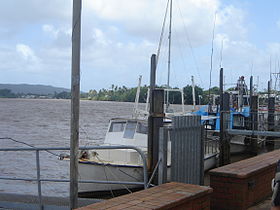Johnstone River
| Johnstone | |
| North Johnstone South Johnstone |
|
| River | |
|
Johnstone River at Innisfail, 2006
|
|
| Name origin: Robert Johnstone, a colonial policeman | |
| Country | Australia |
|---|---|
| State | Queensland |
| Regions | Far North Queensland, North Queensland |
| Tributaries | |
| - left | North Beatrice River, Ithica River |
| - right | Downey Creek |
| City | Innisfail |
| Primary source | Atherton Tableland |
| Secondary source | North Johnstone River |
| - location | Merivale |
| - elevation | 760 m (2,493 ft) |
| - coordinates | 17°25′24″S 145°31′25″E / 17.42333°S 145.52361°E |
| Additional source | South Johnstone River |
| - location | below Mount Father Clancy |
| - elevation | 755 m (2,477 ft) |
| - coordinates | 17°35′37″S 145°36′32″E / 17.59361°S 145.60889°E |
| Source confluence | South Johnstone River and North Johnstone River |
| - location | Innisfail |
| - elevation | 1 m (3 ft) |
| - coordinates | 17°31′25″S 146°02′1″E / 17.52361°S 146.03361°E |
| Mouth | Coral Sea |
| - location | between Flying Fish Point and Coquette Point |
| - elevation | 0 m (0 ft) |
| - coordinates | 17°30′39″S 146°04′36″E / 17.51083°S 146.07667°ECoordinates: 17°30′39″S 146°04′36″E / 17.51083°S 146.07667°E |
| Length | 200 km (124 mi) |
| Basin | 2,320 km2 (896 sq mi) |
| Waterfall | Malanda Falls, Jones Falls, Binda Falls |
| Protected areas | Malanda Falls Conservation Park |
| National parks | Ella Bay, Eubenangee Swamp, Herberton Range, Japoon, Malaan, Moresby Range, Palmerston Rocks, Topaz Road, Tully Falls, Tully Gorge and Wooroonooran |
|
Location of Johnstone River river mouth in Queensland
|
|
The Johnstone River, comprising the North Johnstone River and the South Johnstone River, is a river system located in Far North and North Queensland, Australia.
The headwaters of the river system rise in the Atherton Tablelands. The north branch of the river system rises below Merivale, flows over the Malanda Falls and through the town of Malanda and then flows generally south by east, around Francis Range and over the Jones Falls, before flowing east, covering a distance of 114 kilometres (71 mi). The south branch of the river system rises below Mount Father Clancy and generally flows east over Binda Falls, through the settlement of South Johnstone, before flowing north, covering a distance of 88 kilometres (55 mi). The two rivers reach their confluence to form the Johnstone River east of the town of Innisfail, and just 5 kilometres (3.1 mi) west of the river mouth. The main river then flows east, north of the Moresby Range National Park, and empties into the Coral Sea.
Together, the combined rivers flow over 200 kilometres (120 mi) from source to mouth and descend approximately 760 metres (2,490 ft), with a catchment area of 2,320 square kilometres (900 sq mi).Crocodiles swim & live in all areas in the Johnstone River
The North and South Johnstone Rivers rise in the tablelands of the north tropical coast and flow through steep narrow gorges to their junction on the coastal plain at Innisfail. The head waters of the catchments are located in high rainfall areas and the rivers are capable of producing severe flooding, especially in the Innisfail area. The North and South Johnstone Rivers have a combined catchment area of about 1,600 square kilometres (620 sq mi) at Innisfail; with the North Johnstone being the larger of the two with a catchment of about 1,030 square kilometres (400 sq mi).
...
Wikipedia


